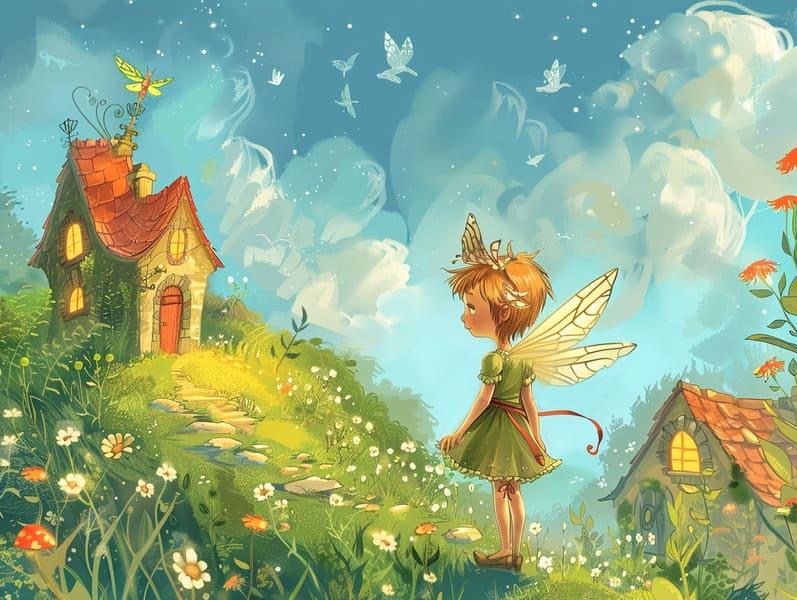
Historical fairy tales have historical significance. These stories have been conveyed from one generation to the next centuries before they were ever inscribed. They originated from a variety of backgrounds, including Middle Eastern traditions. They were initially narrated among adults, often carrying themes and messages reflective of the societal norms and beliefs of the time.
Jacob and Wilhelm Grimm, Jacob and Wilhelm Grimm, were among the first to compile and publish many of these beloved fairy tales. Their published works, "Grimm's Fairy Tales," included stories like "The Little Glass Slipper," "Little Brother and Little Sister," and "Snow White," which have since become essentials in the world of classic fairy tales. Similarly, Hans Andersen's fanciful narratives, such as "The Mermaid," and "The Ugly Duckling," have captivated hearts worldwide, cementing their place in the pantheon of iconic fairy tales.
Even though they are old, traditional fairy tales remain as relevant as ever, especially as kids' bedtime tales. These delightful tales are now available in diverse formats, including beautifully illustrated books, charming animations, and online storybooks.
Their enduring popularity can be linked to several magical reasons:
Significant Morals: Classic fairy tales often share important moral lessons. Fairy tales like "The Story of the Boy Who Cried Wolf" teach the virtue of truthfulness, while "The Tortoise and the Hare" stress the virtues of tenacity and humbleness. These narratives offer kids clear distinctions between moral and immoral, shaping their moral compass in a subtle yet important way.
Compassion and Insight: Ancient fairy tales frequently feature personalities facing challenges and struggles, inciting young listeners to identify with their struggles and support their triumphs. For instance, "The Story of Beauty and the Beast" reveals the virtue of looking deeper to understand the inner being of a individual, encouraging warmth and recognition.
Cultural Insights: Many ancient fairy tales are deeply ingrained in the cultural contexts from which they grew. Engaging with these fairy tales can provide intriguing perspectives into different heritages, enhancing a sense of global appreciation and acknowledgment.
Imagination and Innovation: The mythical elements in ancient fairy tales—talking animals—inspire children’s creative minds. These fairy tales take readers to otherworldly realms, stimulating imaginative thinking and a sense of amazement that continues a lifetime.
Old fairy tales are not only enchanting but also illuminating. They work as enchanted tools in building various cognitive and emotional skills in children. When classic fairy tales are read aloud, they improve communication skills by introducing new lexicon and complicated sentence structures. This practice also advances auditory perception and focus, as young readers remain attentive, excited to see what happens next.
Furthermore, reflecting on the themes and characters of ancient fairy tales can develop cognitive skills and thought processes. Young readers are shown to spot patterns, expect results, and realize cause and effect. These debates also encourage kids reveal their thoughts and feelings, strengthening their emotional intelligence.
In today’s digital age, the abundance of online fairy tales has made these narratives more acquirable than ever. Internet sites and software supply large libraries of famous fairy tales that can be accessed or played anytime, anywhere. Fairy tales voiced are particularly prevalent, giving an captivating way for young ones to experience these fascinating tales. Audiobooks and read-out-loud stories carry characters and settings to life, often supplemented by charming background sounds and musical scores that raise the narrative adventure.
The enduring charm of old fairy tales lies in their ability to alter to modern society while staying true to their core values. Contemporary reinterpretations of these fairy tales often bring in more multicultural characters and modern settings, making them relatable to today’s audience. However, the essential messages of guts, kindness, and fair play remain unchanged, continuing to influence kids of all ages.
Traditional fairy tales also offer a sense of peace and comprehensibility. They get more info yield a well-structured narrative with a obvious beginning, middle, and end, often finishing with the conclusion of conflicts and the triumph of honesty over deceit. This regularity can be heartening for the young, delivering a sense of firmness in an shifting world.
Traditional fairy tales continue to entrance and enlighten new generations, maintaining their spell and pertinence in modern society. As children's bedtime stories, they impart upon a perfect blend of fantasy and learning, encouraging moral values, empathy, and creativity. The proliferation of digital fairy tales and the commonness of fairy tales recited guarantee that these traditional fairy tales remain obtainable to new generations.
By guarding and sharing these narratives, we continue to commemorate the rich tapestry of cultural legacy and cultural heritage. Whether you are delving into a colorful picture book, accessing a virtual library, or hearing an spoken story, the allure of old fairy tales is always within reach. These tales illustrate of the enduring power of storytelling and its ability to bind us across eras and regions.
If you are discovering a gorgeously illustrated book, experiencing a web-based library, or listening to an audiobook, the grace of bedtime fairy tales is always within reach.
These narratives demonstrate of the unchanging presence of stories and its ability to bond us across centuries and lands, casting a charm that charms and informs alike.